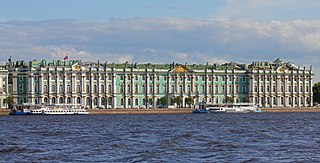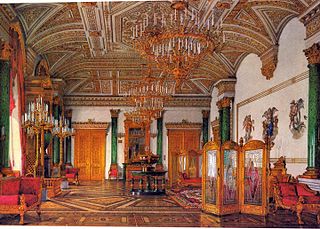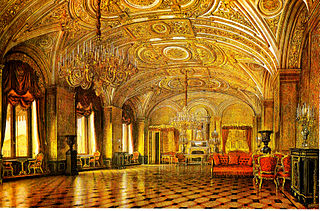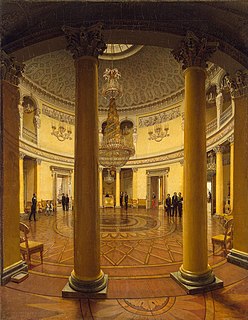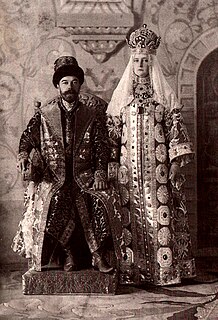

The Arabian Hall, sometimes known as the Blackamoor Hall or the Arabian Dining Room, is one of the private rooms of the Winter Palace in Saint Petersburg. In the Tsarist era, it was the room from which imperial processions through the state rooms began. The double doors [1] were designed to be on a straight axis through the principal state rooms and ultimately the Jordan Staircase, forming an enfilade. Thus it was here the Romanov family often assembled, in private, before state receptions and occasions. [2] The privacy of the room was not compromised by the small private courtyard (see plan) from which windows, which once led to the Tsaritsa's winter-garden below, admitted light.

The Private Apartments of the Winter Palace are sited on the piano nobile of the western wing of the former imperial palace, the Winter Palace in St Petersburg. Access to the private rooms, for members of the Imperial Family, from the exterior was usually through the Saltykov Entrance which was reserved for use by only the Tsar, Tsaritsa and grand dukes and grand duchesses. A second access was through a discrete box-like porch, on the western end of the Palace's Neva façade. From the ground floor, it can be accessed from the October Staircase, formerly known as His Majesty's Own Staircase; this double-flighted imperial staircase was a secondary entrance to the private apartments, and provided a more convenient route to the palace's ground floor and private entrances than the more formal and ceremonial public route through the state apartments. During the October Revolution of 1917, this was the entrance by which the revolutionaries gained access to the palace in order to arrest the Provisional Government in the small private dining room. Since that date it has been known as the October Staircase and has a plaque commemorating the event. Despite its size and grandeur, the October Staircase was a secondary staircase, the Jordan Staircase being the principal.
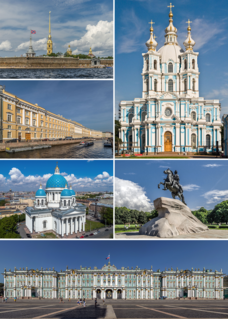
Saint Petersburg is Russia's second-largest city after Moscow, with 5 million inhabitants in 2012, part of the Saint Petersburg agglomeration with a population of 6.2 million (2015). An important Russian port on the Baltic Sea, it has a status of a federal subject.
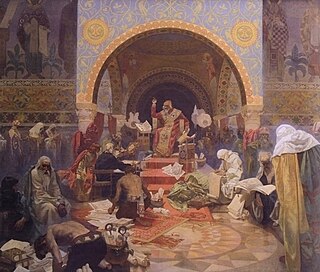
Tsar, also spelled czar, or tzar, is a title used to designate East and South Slavic monarchs or supreme rulers of Eastern Europe, originally Bulgarian monarchs from 10th century onwards. As a system of government in the Tsardom of Russia and the Russian Empire, it is known as Tsarist autocracy, or Tsarism. The term is derived from the Latin word Caesar, which was intended to mean "Emperor" in the European medieval sense of the term—a ruler with the same rank as a Roman emperor, holding it by the approval of another emperor or a supreme ecclesiastical official —but was usually considered by western Europeans to be equivalent to king, or to be somewhat in between a royal and imperial rank.
Contents
Designed by Alexander Briullov following the Winter Palace fire of 1837, the room is decorated in the neoclassical style fashionable in the early 19th century, known as Pompeian. A ceiling, with a low segmental barrel vault with bands of shallow coffering stuccoed with classical motifs, is seemingly supported by a colonnade of engaged fluted Greek Doric columns with enriched echinus molding and no bases. [3] A Greek key fret enriches the entablature that runs without a break round the room. The only furnishings were the dining chairs of Greek klismos type, formally ranged round the walls. When the Imperial family were to dine here, dining tables would be brought in, covered and laid, then removed afterwards. [4]

Neoclassicism is the name given to Western movements in the decorative and visual arts, literature, theatre, music, and architecture that draw inspiration from the "classical" art and culture of classical antiquity. Neoclassicism was born largely thanks to the writings of Johann Joachim Winckelmann, at the time of the rediscovery of Pompeii and Herculaneum, but its popularity spread all over Europe as a generation of European art students finished their Grand Tour and returned from Italy to their home countries with newly rediscovered Greco-Roman ideals. The main Neoclassical movement coincided with the 18th-century Age of Enlightenment, and continued into the early 19th century, laterally competing with Romanticism. In architecture, the style continued throughout the 19th, 20th and up to the 21st century.

Pompei is a city and comune in the Metropolitan City of Naples in Italy, home of the ancient Roman ruins part of the UNESCO World Heritage Sites.
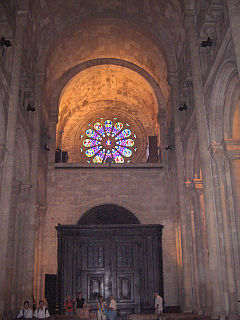
A barrel vault, also known as a tunnel vault or a wagon vault, is an architectural element formed by the extrusion of a single curve along a given distance. The curves are typically circular in shape, lending a semi-cylindrical appearance to the total design. The barrel vault is the simplest form of a vault: effectively a series of arches placed side by side. It is a form of barrel roof.
The various geographically confused names of the Arabian Hall derive, not from any peculiar contents, but from the four official pseudo-bodyguards of the Tsar who travelled from palace to palace with the Imperial family. They were four "massive Negroes" fantastically dressed in scarlet trousers, gold jackets, white turbans and curved shoes. [5] Wherever the Tsar was, they guarded the doors between the private and official world. They had no other function other than to open and close doors; their sudden, but silent appearance into a room was the signal that heralded the immediate appearance of the Tsar or Tsaritsa.
Although the guards were referred to as the Ethiopians or Blackamoors, from 1896, at least one was an American. Jim Hercules holidayed in the US and always returned with jars of guava jelly for the Imperial children. [6]

Ethiopia's population is highly diverse. Most of its people speak a Semitic or Cushitic language which are both part of the Afroasiatic language family. The Oromo, Amhara, Somali and Tigrayans make up more than three-quarters (75%) of the population, but there are more than 80 different ethnic groups within Ethiopia. Some of these have as few as 10,000 members. English is the most widely spoken foreign language and is taught in all secondary schools. Amharic was the language of primary school instruction but has been replaced in many areas by local languages such as Oromifa, Somali and Tigrinya.

Guava is a common tropical fruit cultivated in many tropical and subtropical regions. Psidium guajava is a small tree in the myrtle family (Myrtaceae), native to Mexico, Central America, and northern South America. Although related species may also be called guavas, they belong to other species or genera, such as the "pineapple guava" Acca sellowiana. In 2011, India was the largest producer of guavas.
Today, the empty hall is occasionally used for special exhibitions held by the State Hermitage Museum.

